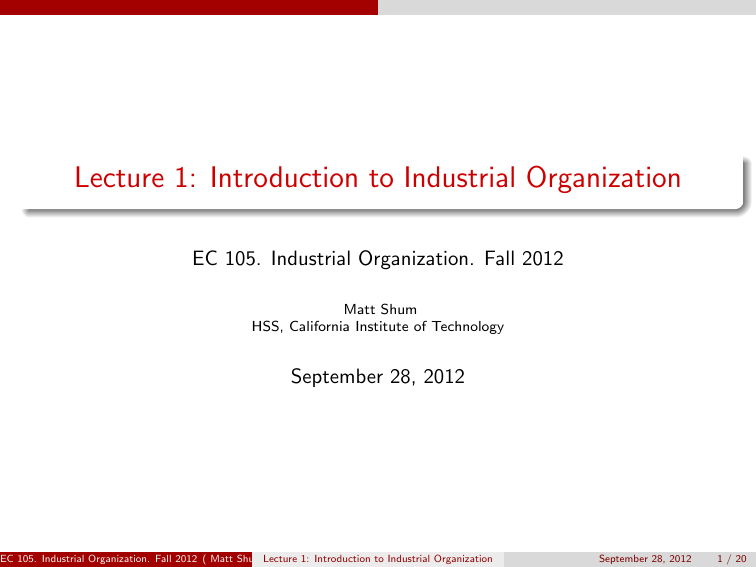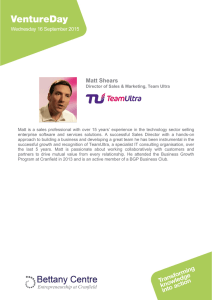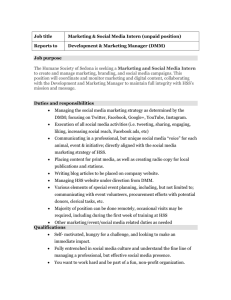Lecture 1: Introduction to Industrial Organization
advertisement

Lecture 1: Introduction to Industrial Organization EC 105. Industrial Organization. Fall 2012 Matt Shum HSS, California Institute of Technology September 28, 2012 EC 105. Industrial Organization. Fall 2012 ( Matt ShumLecture HSS, California 1: Introduction InstitutetoofIndustrial Technology) Organization September 28, 2012 1 / 20 Outline Outline 1 Course Information 2 Overview of the Course 3 Technology and Costs EC 105. Industrial Organization. Fall 2012 ( Matt ShumLecture HSS, California 1: Introduction InstitutetoofIndustrial Technology) Organization September 28, 2012 2 / 20 Course Information Course Information EC 105. Industrial Organization. Fall 2012 ( Matt ShumLecture HSS, California 1: Introduction InstitutetoofIndustrial Technology) Organization September 28, 2012 3 / 20 Course Information Contact Information Office: 301D Baxter; email: mshum@caltech.edu Secretary: Barbara Estrada (bestrada@hss.caltech.edu) Website: www.hss.caltech.edu/ mshum/ec105.html Please check website regularly for announcements; class handouts, notes, &etc EC 105. Industrial Organization. Fall 2012 ( Matt ShumLecture HSS, California 1: Introduction InstitutetoofIndustrial Technology) Organization September 28, 2012 4 / 20 Course Information Suggested Textbooks and References Standalone lecture notes, supplemented by papers and handouts Some suggested textbooks: The Theory of Industrial Organization. MIT Press 1988, by Jean Tirole. Modern Industrial Organization. Harper/Collins, by D. Carlton and J. Perloff. EC 105. Industrial Organization. Fall 2012 ( Matt ShumLecture HSS, California 1: Introduction InstitutetoofIndustrial Technology) Organization September 28, 2012 5 / 20 Course Information Course Policies Grades are based on the following weighting scheme: Problem Sets (0.15), Midterm (0.25), Paper/Presentation (0.30), Final (0.30). Midterm and Final examinations will be closed-book. Collaboration on the examinations is prohibited. Paper/presentation will be to find and study real world examples of the phenomena we discuss in this class. Periodic “progress reports” (every 2-3 wks) will be required. Collaboration on Assignments is allowed and encouraged, but final solutions must be written independently. Each student should participate fully in solving each problem and understand the answer. Late assignments will not be accepted (unless approved by the Dean of Students). The date that an assignment is due will be announced in lecture when the assignment is distributed. Assignments will be due in class at the start of the lecture on the day they are due. EC 105. Industrial Organization. Fall 2012 ( Matt ShumLecture HSS, California 1: Introduction InstitutetoofIndustrial Technology) Organization September 28, 2012 6 / 20 Overview of the Course Overview of the Course EC 105. Industrial Organization. Fall 2012 ( Matt ShumLecture HSS, California 1: Introduction InstitutetoofIndustrial Technology) Organization September 28, 2012 7 / 20 Overview of the Course Topics to be covered I. Market structure 1 Intro & Review. Technology and Costs. Perfect competition. Monopoly. Measuring market power. 2 Imperfect (oligopolistic) Competition. Introduction to game theory. Static games. Nash Equilibrium. Prisoner’s dilemma. Cournot model. Bertrand model. Capacity constraints in price competition. 3 Cartels and collusion Multi-period (“dynamic”) games. Extensive form games. Subgame perfect equilibrium. Stackelberg model. Repeated games and tacit collusion. Reading: Porter (1983) EC 105. Industrial Organization. Fall 2012 ( Matt ShumLecture HSS, California 1: Introduction InstitutetoofIndustrial Technology) Organization September 28, 2012 8 / 20 Overview of the Course Topics to be covered II. Firm practices 1 Incumbent advantage. Incumbent advantage. Limit pricing and credibility. Dixit model of capacity investment. 2 Product differentiation. Product differentiation resolves Bertrand paradox. Spatial Competition. Pricing, Location and Entry. 3 Price discrimination. Perfect, 2nd-degree, 3rd-degree price discrimination. Nonlinear pricing and bundling. Application: post-patent drug price anomaly. 4 Vertical restraints. Vertical Externalities (Double Marginalization, Downstream Moral Hazard) and Vertical Restraints (Exclusive Territories, Tie-In, Resale Price Maintenance, etc.). EC 105. Industrial Organization. Fall 2012 ( Matt ShumLecture HSS, California 1: Introduction InstitutetoofIndustrial Technology) Organization September 28, 2012 9 / 20 Overview of the Course Topics to be covered III. Information economics 1 Price dispersion and search. Price dispersion for homogeneous products. Diamond paradox. Equilibrium price dispersion with costly search. Applications: online books, gasoline markets. 2 Lecture 9: Auctions. Games of incomplete information. Bayesian equilibrium. First-price auctions, second-price auctions. Winner’s curse. Applications: online auctions. 3 Additional topics (as time allows). Various sections of these lecture notes draw heavily on lecture notes written by Matias Iaryczower (Princeton). ¡Muchas gracias! EC 105. Industrial Organization. Fall 2012 ( Matt ShumLecture HSS, California 1: Introduction InstitutetoofIndustrial Technology) Organization September 28, 2012 10 / 20 Technology and Costs The Cost Function Cost function C (q): minimum cost of producing a given quantity q C (q) = F + VC (q), where Fixed costs F : cost incurred regardless of output amount. Avoidable vs. sunk: crucial for determining shut-down decisions for the firm. Variable costs VC (q); vary with the amount produced. Average cost AC (q) = C (q) q ∂C (q) ∂q AFC (q) = Fq Marginal cost MC (q) = AVC (q) = VC (q) ; q ; AC (q) = AVC (q) + AFC (q). EC 105. Industrial Organization. Fall 2012 ( Matt ShumLecture HSS, California 1: Introduction InstitutetoofIndustrial Technology) Organization September 28, 2012 11 / 20 Technology and Costs Example C (q) = 125 + 5q + 5q 2 AC (q) = MC (q) = AFC (q) = 125/q AVC (q) = 5 + 5q q AC(q) MC(q) 1 135 15 3 61.67 35 5 55 55 7 57.86 75 9 63.89 95 AC rises if MC exceeds it, and falls if MC is below it. Implies that MC intersects AC at the minimum of AC. EC 105. Industrial Organization. Fall 2012 ( Matt ShumLecture HSS, California 1: Introduction InstitutetoofIndustrial Technology) Organization September 28, 2012 12 / 20 Technology and Costs Short-run vs. long-run costs: Short run: production technology given Long run: can adapt production technology to market conditions Long-run AC curve cannot exceed short-run AC curve: its the lower envelope Example: “The division of labor is limited by the extent of the market” (Adam Smith) Division of labor requires high fixed costs (for example, assembly line requires high setup costs). Firm adopts division of labor only when scale of production (market demand) is high enough. Graph: Price-taking firm has “choice” between two production technologies. EC 105. Industrial Organization. Fall 2012 ( Matt ShumLecture HSS, California 1: Introduction InstitutetoofIndustrial Technology) Organization September 28, 2012 13 / 20 Technology and Costs Opportunity cost The opportunity cost of a product is the value of the best forgone alternative use of the resources employed in making it. Normal profit of a product is its selling price minus opportunity cost. Quit when normal profit < 0. (vs. accounting profits) Example: Car factory: a worker would make $5 an hour Two brothers, who make one lamp each hour, with materials costing $7 What is opportunity cost of lamp? Normal profit when market price of lamp is $11? $10? $9? EC 105. Industrial Organization. Fall 2012 ( Matt ShumLecture HSS, California 1: Introduction InstitutetoofIndustrial Technology) Organization September 28, 2012 14 / 20 Technology and Costs Economies of scale: slope of AC curve AC 0 (q) < 0: increasing returns to scale AC 0 (q) > 0: decreasing returns to scale AC 0 (q) = 0: constant returns to scale Example: U-shaped AC curve Factors affecting scale economies: Fixed costs Congestion specialization Minimum efficient scale of production: smallest output which minimizes (long-run) AC. EC 105. Industrial Organization. Fall 2012 ( Matt ShumLecture HSS, California 1: Introduction InstitutetoofIndustrial Technology) Organization September 28, 2012 15 / 20 Technology and Costs Multiproduct firms: Economies of Scope C (q1 , q2 ) < C1 (q1 ) + C2 (q2 ) Example (common fixed costs): C1 (q1 ) = 10 + 2q1 C2 (q2 ) = 10 + 3q2 C (q1 , q2 ) = 10 + 2q1 + 3q2 Depends on levels of q1 , q2 : C1 (q1 ) = 5 + 2q1 C2 (q2 ) = 5 + 3q2 C (q1 , q2 ) = 10 + 3q1 + 2q2 Consider two output levels: 1 and 2 (q1 , q2 ) C1 (q1 ) C2 (q2 ) C (q1 , q2 ) (1,1) (1,2) (2,1) (2,2) EC 105. Industrial Organization. Fall 2012 ( Matt ShumLecture HSS, California 1: Introduction InstitutetoofIndustrial Technology) Organization September 28, 2012 16 / 20 Technology and Costs Economies of Scope: Ray Average Costs How to measure economics of scale for multiproduct firms? Need to define appropriate notion of “average costs” for this firm. What is AC for a multiproduct firm? Assume production of the different products i = 1, . . . , N inP fixed proportions, and let these proportions be λ1 , . . . , λN , with i λi = 1. Let q1 , . . . , qN denote production of the different products, and q = q1 + q2 + .... Then define λi = qi /q, the “proportion” of component i in the total production. Note that qi = λi q. EC 105. Industrial Organization. Fall 2012 ( Matt ShumLecture HSS, California 1: Introduction InstitutetoofIndustrial Technology) Organization September 28, 2012 17 / 20 Technology and Costs Economies of Scope: Ray Average Costs (contd) Example: Shoe factory q1 is number of right shoes q2 is number of left shoes λ1 = 0.5, λ2 = 0.5 Example: auto (one body plus four wheels) Define: Ray Average Costs (RAC(q)) for the composite quantity q: C (λ1 q,...,λN q) q Graph: RAC concept only considers production combinations along “rays”. Example: Shoe factory C (q1 , q2 ) = 100 + 5q1 + 5q2 , then RAC(q) is 100+5q 1 . q ∗ [100 + 5λ1 q + 5λ2 q] = q Slope of RAC(q) curve determines economies of scale for a multiproduct firm. EC 105. Industrial Organization. Fall 2012 ( Matt ShumLecture HSS, California 1: Introduction InstitutetoofIndustrial Technology) Organization September 28, 2012 18 / 20 Technology and Costs Economies of Scope: discussion Reasons for Economies of Scope 1 Common inputs (cow yields beef and leather) 2 Marketing channels (“umbrella branding”: Regular, Honey Nut, and Apple-Cinnamon Cheerios) 3 Deregulation: leads to conslidation in many sectors (telecom, FIRE). Reveals underlying economies of scope? Are there alternative explanations? 4 Japanese keiretsu; Korean chaebol EC 105. Industrial Organization. Fall 2012 ( Matt ShumLecture HSS, California 1: Introduction InstitutetoofIndustrial Technology) Organization September 28, 2012 19 / 20 Technology and Costs Summary Define: cost function Returns to scale Economies of Scope EC 105. Industrial Organization. Fall 2012 ( Matt ShumLecture HSS, California 1: Introduction InstitutetoofIndustrial Technology) Organization September 28, 2012 20 / 20


